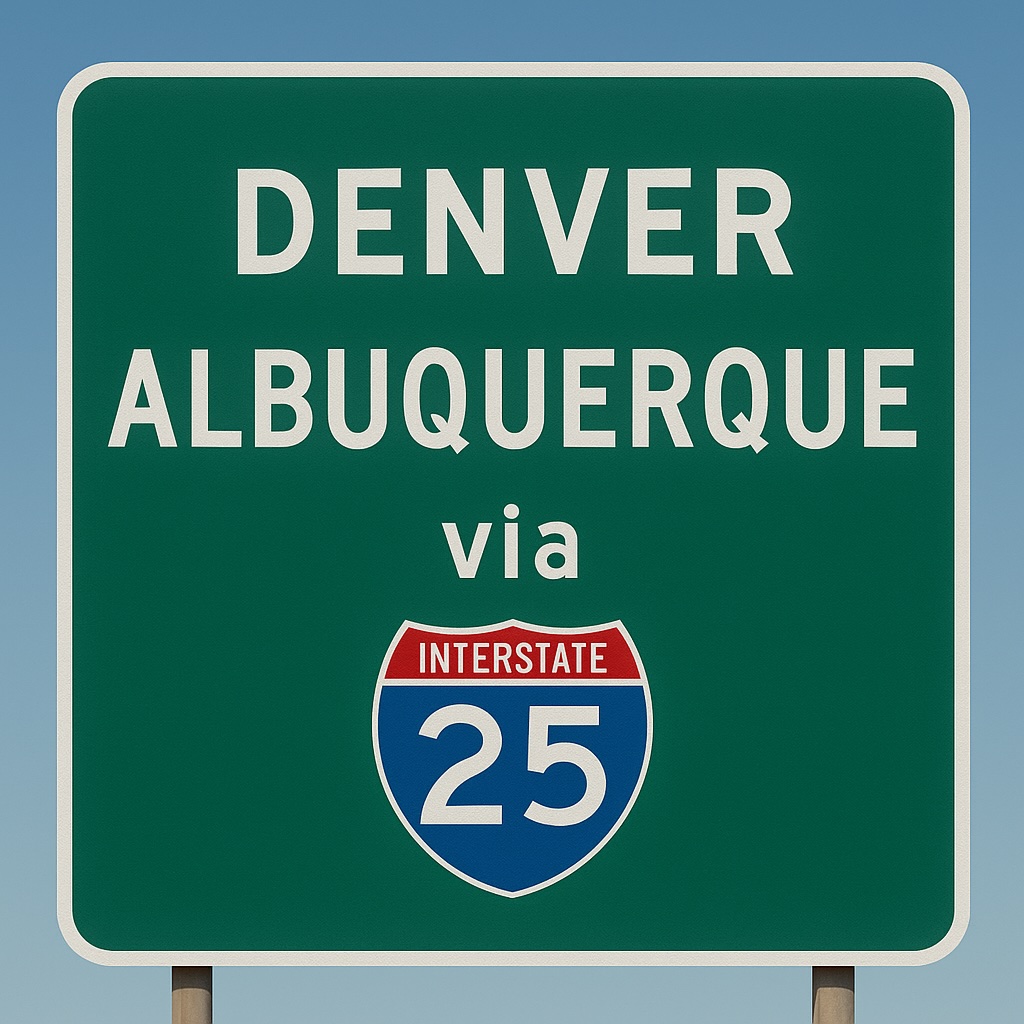It is a trip that may not have the same catchy beat as the classic “Route 66,” performed by countless artists, but Interstate 25 from Denver to Albuquerque has as many—maybe more—interesting stops “along the way.”

The drive from Denver to New Mexico’s biggest city is, give or take, 444 miles. At 75 miles per hour, it’s a six-hour drive. That’s non-stop. But, because Mother Nature and pure curiosity make the calls, bank on something closer to a seven, maybe eight; maybe more. Let’s explore.
On a clear day, the drive includes a great western view of the state’s Front Range, straight-to-the-sky mountains bathed in hues of blues. As Denver’s southern suburbs disappear, you’re in Castle Rock, home of the ever popular outlet shops. You can stop on the return trip. Now, on to ‘the Springs.’
On the open road, with Pikes Peak looming large, the views just get better. You can detour for pictures, but let’s forge ahead.
Some days you might see Air Force Academy pilot candidates doing touch-and-goes. You’ll certainly see Falcon Stadium and the Academy’s iconic spired chapel.
Next up, Colorado Springs and forty or so minutes later, Pueblo, home of ‘the best chili’ in the country, the River Walk and coming this Fall, the country’s first dedicated Leonardo da Vinci Museum.
Just south of Pueblo is the Wet Mountain range and Greenhorn Mountain its most prominent peak. The next stop is Walsenburg, one of Colorado’s oldest towns.
Originally, La Plaza de los Leones, Walsenburg was settled in 1859. Coal, abundant in the region, fueled the town’s early growth; immigrants providing the muscle.
Twenty-four miles south of Walsenburg is County Road 44, the turnoff for the Ludlow Massacre Memorial. The stark and simple monument honors the April 20th, 1914, victims of the massacre. They were mostly immigrant women and small children slain by the National Guard and strikebreakers hired by the Rockefeller family. Historians have called Ludlow “the culminating act of perhaps the most violent struggle between corporate power and laboring men in American history.”
Minutes later, it’s Trinidad, another of the state’s earliest settlements. “We’re more than a gas stop,” says Pat Howlett, President of the town’s Chamber of Commerce. Howlett almost swoons describing his adopted town. “Our buildings are grand,” he says of the majesty of the town’s golden age architecture. They deserve to be on postcards, Howletts says, hiding not a sliver of pride.
The late Denver icon and architectural conservationist Dana Crawford, Howlett said, saw in Trinidad what others might not have. Crawford loved Trinidad and, Howlett said, bought the home once reserved for the president of the town’s college. It was her part-time residence.
Besides being “one of the most walkable towns in Colorado,” Howlett says it’s also “the state’s best kept secret.” It has two state parks nearby, beautiful mountains and a Native American, Spanish and Mexican history to complement its U.S. history.
Just across the state line you hit Raton, Spanish for ‘mouse.’ The town, population 5,000 (plus or minus), is home to retired public defender and Los Angeles expatriate David Patton. He likes Raton with some reservation. “You don’t have the traffic or anonymity…I thought it would be warmer.” His wife, from nearby Cimarron, is a fourth-generation rancher. Overall, he says, “I’m comfortable.”
Las Vegas—no! The New Mexico ‘Vegas,’ is Raton’s ‘big city.’ Think of ‘Raton’ as the moon; Las Vegas, the ‘Earth.’ It has the amenities missing in Raton, including movie theaters. But it also has the historic Castaneda Hotel, the Dwan Light Sanctuary on the campus of the United World Center Campus, a prismatic art installation, The People’s History of El Norte, a muralistic history of the land and more. It’s worth the trip.
Another hour away is Santa Fe, the historic capitol city of ‘the land of enchantment.’ It was established in 1610 and is the country’s oldest working capitol. Santa Fe, population 90,000, is the state’s tourism magnet, boasting arts, including the world famous Santa Fe Opera, food and history. Santa Fe, it’s a must-stop, must-see point of interest.
We wind up the trip some 60 or so miles south and in Albuquerque. One of the boom towns of the West, Albuquerque, is full of fascinating diversions including the world famous Sandia Peak Tramway. Located on the edge of the city, the country’s longest aerial tram and third longest in the world, takes visitors on a two and a half mile trip to the top of Sandia Peak. Acrophobics, take note.
Also, among scores of diversions in Albuquerque are the Albuquerque Isotopes, formerly the Dukes. The team carries the namesake of Homer Simpson’s hometown team, the Springfield Isotopes. Also, the city is the fictional home of Saul of ‘Better Call Saul,’ television fame and actor Brian Cranston’s “Breaking Bad.”
New Mexico bonus: Drive another 200 miles south you visit the world famous Zuhl Museum in Las Cruces. “Part Art, Part History,” is what the ‘best darned geology museum’ in the West calls itself.
“I believe that the Zuhl is one of the coolest places you can see,” which includes the largest collection of petrified wood in the country, said New Mexico State University geology student, jagger Gissing in describing the state’s most sophisticated ‘rock garden.’ It’s a rock hounds’ dream.



